| Lesson 3 | Creating a procedure |
| Objective | Create procedure to calculate sales transaction. |
Creating an Oracle Procedure
Create a procedure to calculate a percentage and an average for a given sales transaction.
A procedure is created by using the CREATE PROCEDURE command and blocks of PL/SQL statements. Use the SlideShow below to see how a procedure is built. The following series of images walks you through creating a procedure that accepts a primary key field as an incoming parameter and sends two calculated values back to two outgoing parameters.
A procedure is created by using the CREATE PROCEDURE command and blocks of PL/SQL statements. Use the SlideShow below to see how a procedure is built. The following series of images walks you through creating a procedure that accepts a primary key field as an incoming parameter and sends two calculated values back to two outgoing parameters.
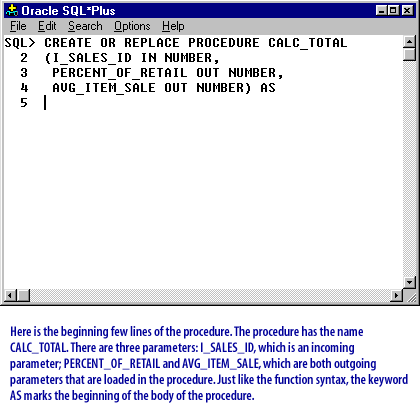
SQL> CREATE OR REPLACE PROCEDURE CALC_TOTAL (I_SALES_ID IN NUMBER, PERCENT_OF_RETAIL OUT NUMBER, AVG_ITEM_SALE OUT NUMBER) AS |
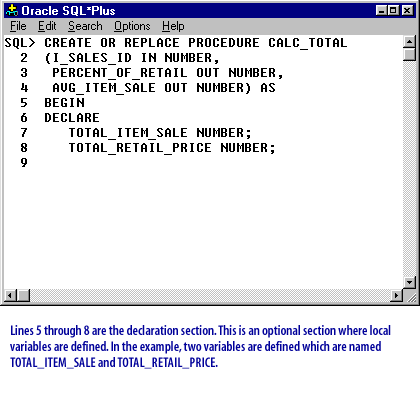
SQL> CREATE OR REPLACE PROCEDURE CALC_TOTAL (I_SALES_ID IN NUMBER, PERCENT_OF_RETAIL OUT NUMBER, AVG_ITEM_SALE OUT NUMBER) AS BEGIN DECLARE TOTAL_ITEM_SALE NUMBER; TOTAL_RETAIL_PRICE NUMBER;
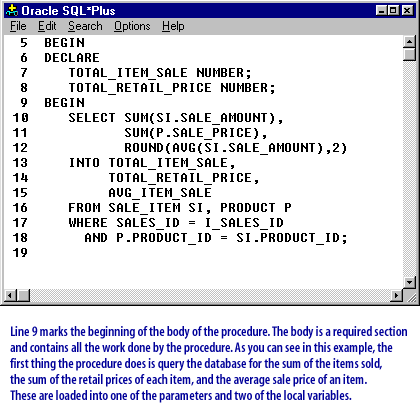
BEGIN
DECLARE
TOTAL_ITEM_SALE NUMBER;
TOTAL_RETAIL_PRICE NUMBER;
BEGIN
SELECT SUM(SI.SALE_AMOUNT),
SUM(P.SALE_PRICE),
ROUND(AVG(SI.SALE_AMOUNT),2)
INTO TOTAL_ITEM_SALE,
TOTAL_RETAIL_PRICE,
AVG_ITEM_SALE
FROM SALE_ITEM SI, PRODUCT P
WHERE SALES_ID - I_SALES_ID
AND P.PRODUCT_ID - SI.PRODUCT_ID;
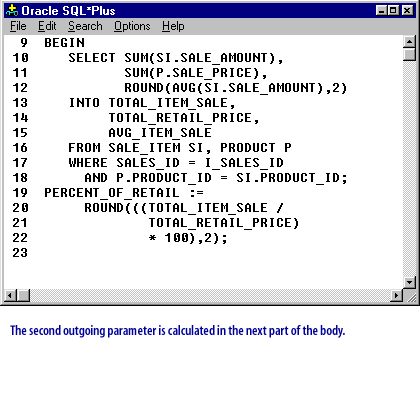
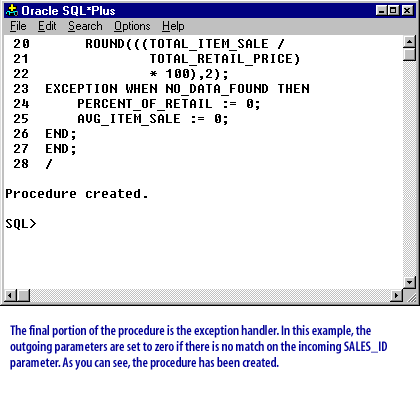
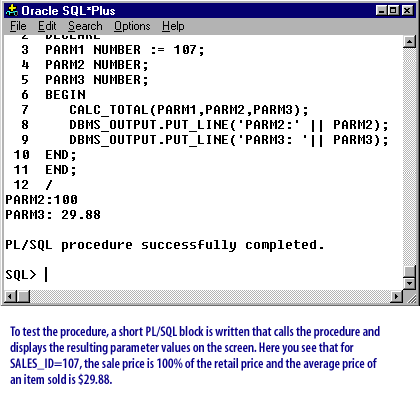
Oracle Procedure using Return The following procedure definition uses the return definition.
A function returns a datatype, not a variable.
SQL> create or replace function calc_area 2 (n_length in number, 3 n_width in number) 4 return number 5 as 6 begin 7 return n_length*n_width; 8 end;/ Function created.
calc_area returns number
In the PL/SQL code shown above, the function calc_area is defined so that it returns a number.
In the function body there must be a RETURN statement defining what is returned. In the example above, the RETURN statement is at line 4.
A function name can be very descriptive with up to 32 characters and the function is always created in the schema of the user that creates the function.
As with the procedure, a function can declare any number of values in the declaration section, limited only by the usability of the function. However, unlike a procedure, a function can not be passed variables in mode OUT or INOUT.
A function can only return a datatype and if a function is defined with an
ORA-06572: Function <name> has out arguments
An example used earlier in the book converted a temperature in Fahrenheit to Celsius. This is a perfect example of a function, which takes a value and returns a number.
Function created.
A function can only return a datatype and if a function is defined with an
- OUT or
- INOUT
ORA-06572: Function <name> has out arguments
An example used earlier in the book converted a temperature in Fahrenheit to Celsius. This is a perfect example of a function, which takes a value and returns a number.
SQL> create or replace function f2c 2 (n_faren IN number) 3 return number 4 as 5 n_cel number := 0; 6 begin 7 n_cel := (5/9)*(n_faren -32); 8 return n_cel; 9 end; 10 /
Function created.
The next lesson examines the capabilities and restrictions of calling other procedures.
Click the link below to create a procedure for the course project.
Click the link below to create a procedure for the course project.
Create Replace Procedure
Steps to create a "Replace Procedure".
- You began your procedure by typing
CREATE OR REPLACE PROCEDURE SHIPPING_FEEand pressing Enter. - To define the incoming parameter, you typed
(I_SALES_ID IN NUMBER) ASand approved the entry by pressing Enter. - You began typing in the declaration section to define the first variable. You typed
V_SHIPPING_FEE NUMBER;and approved the entry by pressing Enter. - Then you typed
BEGINand pressed Enter to start the main block of the procedure. - Next, you typed
SELECT TOTAL_SALE_AMOUNT,and pressed Enter. This was the first line of a query. - You continued to define another part of the query by typing
V_TOTAL_SALE, V_TOTAL_ITEM, V_TAXand pressing Enter. - You finished the query by typing
SALES_ID = I_SALES_ID;and pressing Enter. - Next, you created a calculation for the shipping fee by typing
V_SHIPPING_FEE := V_TOTAL_ITEM * .10;and pressing Enter. - You finished the second calculation for the total sales by typing
V_TOTAL_ITEM + V_SHIPPING_FEE + V_TAX;and pressing Enter. - You create the beginning of an update command by typing
UPDATE CUSTOMER_SALEand pressing Enter. - Then you continue by defining the first column to be updated by typing
SET TOTAL_SALE_AMOUNT = V_TOTAL_SALE,and pressing Enter. - The rest of the UPDATE command was added for you. Now, you type
END;and press Enter to complete the body of the procedure. - To execute your block, you typed
/at the SQL4 prompt and pressed Enter. - SQL*Plus then displayed the result of the compilation of your block.
- Next, you executed the procedure by typing EXECUTE SHIPPING_FEE(107); and pressing Enter. You see the results of the command in the final screen.
The complete text of the procedure is:
CREATE OR REPLACE PROCEDURE SHIPPING_FEE (I_SALES_ID IN NUMBER) AS BEGIN DECLARE V_SHIPPING_FEE NUMBER; V_TOTAL_ITEM NUMBER; V_TOTAL_SALE NUMBER; V_TAX NUMBER; BEGIN -- query the table now. SELECT TOTAL_SALE_AMOUNT, TOTAL_ITEM_AMOUNT, TAX_AMOUNT INTO V_TOTAL_SALE,V_TOTAL_ITEM, V_TAX FROM CUSTOMER_SALE WHERE SALES_ID = I_SALES_ID; V_SHIPPING_FEE := V_TOTAL_ITEM * .10; V_TOTAL_SALE := V_TOTAL_ITEM + V_SHIPPING_FEE + V_TAX; -- update the table now. UPDATE CUSTOMER_SALE SET TOTAL_SALE_AMOUNT = V_TOTAL_SALE, SHIPPING_HANDLING_FEE = V_SHIPPING_FEE WHERE SALES_ID = I_SALES_ID; END; END;
Built-in SQL functions
Question: How do you write your own built-in SQL functions?
Answer: A function is a PL/SQL named block that returns a value. It is commonly used to convert or assign values.
Note the following: 1) A procedure is executed, 2) a function is called, as in the example below:
In the code fragment above, the area is calculated using a procedure named
The procedure was passed three values and it copied the calculated area into the
Answer: A function is a PL/SQL named block that returns a value. It is commonly used to convert or assign values.
Note the following: 1) A procedure is executed, 2) a function is called, as in the example below:
Begin get_area(11,22,n_area); n_area := calc_area(11,22); End;
In the code fragment above, the area is calculated using a procedure named
get_area and a function named calc_area.
The procedure was passed three values and it copied the calculated area into the
n_area variable when the procedure exited.
The next line uses a function that is 1) passed two values, 2) calculates the area, and 3) returns that value, which is assigned to the n_area variable. Notice that the function is used directly in the assignment operation. A function is defined in the format below.
create or replace function <Name> (<variable list>) return <datatype> as (or is) local variable declaration begin code section exceptions end;